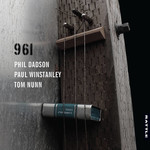
961
 $30.00
In Stock
add to cart
more by this artist
$30.00
In Stock
add to cart
more by this artist
Phil Dadson, Paul Winstanley, Tom Nunn
961
[ Rattle Records / CD ]
Release Date: Friday 20 September 2019
Presented in a beautiful hard-cover art book. 961, the moniker for a building situated at 961 Field Rd, Marin Headlands (USA), became the project tag for a weekly collaboration between Tom Nunn (US), Paul Winstanley (US/NZ) and Phil Dadson (NZ).
During Phil's three-month artist residency at Headlands Centre for the Arts in 2016, building 961 was converted into a multi-voiced instrument with long metal rods, wooden dowels and long wire zithers installed directly into floor and wall surfaces. A modified rocking chair (Tone-throne) with tuned rods of wood and steel, and two sets of clashing cymbals operated by long wires attached front and back to the rocker action, occupied centre-space. This, along with the colourful timbral mix of our individual instruments, transformed 961 into a sonic play-space for our project.
This recording was the trio's very last session, an unbroken hour-long improvisation performed for an audience of invited friends and fellow artists.
PAUL WINSTANLEY
Paul prepares his electric bass in order to extend the sonic possibilities of the instrument, by incorporating a range of tunings and string gauges, using an array of objects either in or on the strings, such as knitting needles, chopsticks, and magnets, employing a variety of devices to excite the strings, such as nails, viol bows, screwdrivers, bottleneck slides, and threaded rods, and by using over-amplified micro-sounds, such as direct string to pick-up contact, electric motors, and steel wool.
Along with a compliment of FX pedals, these implements are part of an expanding stockpile of ingredients that Paul uses to contribute to whatever improvising situation he finds himself in. Paul began his journey into sonic art in his early-teens with a piece called Opus1, a physical deconstruction (using sandpaper, laceration, road-wear) of a 45rpm 7" vinyl of Barry McGuire's 'Eve of Destruction'. He soon began to investigate the sonic possibilities of the bass guitar, which initiated a search for unique sounds and alternative approaches to playing methods that continues to this day.
TOM NUNN
Tom has designed, built, and performed with original musical instruments since 1976. His instruments are sculptural in appearance, are typically constructed using commonly available materials, often employ amplification, and designed specifically for improvisations that favour ambiguity, unpredictability, and nonlinearity. He has created well over 300 instruments, representing three basic types: space plates; electroacoustic percussion boards; and skatchboxes.
Space plates are metal sheets with bronze rods that are bowed or struck, and the plate is supported by inflated balloons that allow it to resonate freely. Electro-acoustic percussion boards are plywood sheets with various hardware devices attached, such as nails, threaded steel rods, bronze rods, and combs, all played with a variety of small percussion implements. Skatchboxes/skatchplates are cardboard boxes/constructions with various objects glued to the exterior that are played with specially shaped combs.
PHIL DADSON
Artist/musician & founder of New Zealand's best-known art/music group, From Scratch, Phil has designed and built an extensive ensemble of instruments out of industrial and natural materials since the early 1970s. His personal instruments are electroacoustic, hybrid and multi-voiced, incorporating springs, strings, membranes and polystyrene resonators. They include the Sprong, Gloop, Gliss-flute, song/stone, osti-fans and edge-tone whistle families.
His solo performances and exhibitions include sound and video installations, music and visual music compositions, sound sculptures, collaborations and improvisations with his instruments.
Tracks:
Portal One (East) 09:57
Accretion 08:00
Portal Two (South) 06:58
Mantle 11:28
Portal Three (West) 06:31
Sycline 06:32
Portal Four (North) 10:42